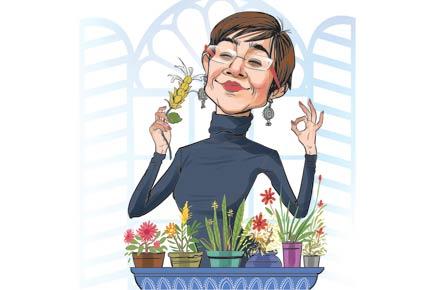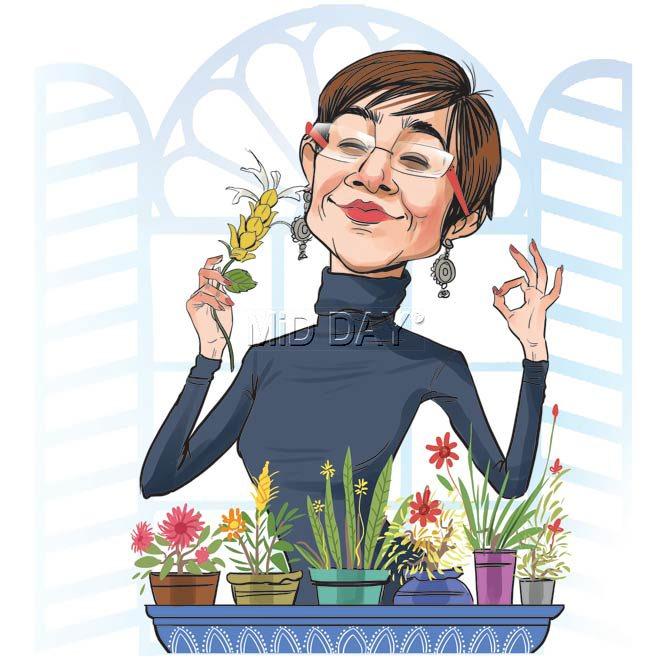AS TS ELIOT wrote in his poem The Naming of Cats, in Old Possum's Book of Practical Cats


Illustration/Uday Mohite
ADVERTISEMENT
 AS TS ELIOT wrote in his poem The Naming of Cats, in Old Possum's Book of Practical Cats:
AS TS ELIOT wrote in his poem The Naming of Cats, in Old Possum's Book of Practical Cats:
"The Naming of Cats is a difficult matter,
It isn't just one of your holiday games;
You may think at first I'm as mad as a hatter
When I tell you, a cat must have THREE DIFFERENT NAMES."
Well, I can tell you, the naming of flowers is pretty much in the same league. Now, the 'palace' part of my little 1BHK is the balcony, because it overlooks a magnificent, six storey-high raintree, and has a row of happy plants with nodding flowers. Basically, they are fans of Ogden Nash, who wrote in Spring's Song: "Listen buds it's March twenty first, Don't you know enough to burst?"
Bougainvillea, begonia, hydrangea, periwinkle, these I know. I promptly gave 'pet names' to those whose names I didn't know — Red Tufty, Mango Lollipop, White Waterfall. Seedhi baat hai. One day, caught deep in the coils of Google Mata, I looked up their official names. I was surprised to discover not only their botanical names, but that the plants I'd bought from nondescript plant nurseries in Santa Cruz, Andheri and Khar, originally came from as far as Mexico, Peru and Senegal.
Red Tufty's daak naam is Powder Puff, but with its fluffy mass of red stamens, its bhalo naam or botanical name is Calliandra haematocephala. I mean, the poor thing, don't flowers have any veto rights at all? I wonder if flowers have morchas to protest against tongue-twister botanical names. But Google Mata patiently explained that the name of this flower, that is native to Mexico and Central America, means "beautiful guy with the red head". Calliandra comes from the Greek kallos (beauty) and andros (man, here stamens), and haematocephala from haimatos, of blood (red) and kephale, head. Can't argue with that one.
Then there's Mango Lollipop. This is an extravagant chap, a ziggurat-shaped flower with scaly, yellow bracts (petal-leaves), and cheery white mini-flowers waving hither and thither from their midst. I discovered that it is called Lollipop or Golden Shrimp Plant, whose botanical name is Pachystachys lutea. Baap re! The flower morcha will spark a riot now. Turns out it is from Peru — who knew! — and that it comes from the Greek pachys, thick, stachys, spike, and lutea, yellow. OK, the Greeks were saying practically the same thing in other words.
Then comes my favourite, White Waterfall, a creeper with an exotic shower of white, bell-shaped flowers (actually the calyx) with smaller, crimson red petals within. The flowers spew long stamens so delicately, it somehow looks as if they're whistling. Native to West Africa from Cameroon to Senegal, it is commonly called Bleeding Heart Vine or Glory Bower. Its botanical name is Clerodendrum thomsoniae, from the Greek kleros (chance) and dendron (tree), possibly referring to the occasionally dubious medicinal qualities associated with some plants.
'Thomsoniae' is in honour of Rev. William Cooper Thomson (d. 1878), a missionary, physician and plant collector in Nigeria, who "discovered" it. The species was named "thomsoniae" after he sent the plant from Nigeria to the Edinburgh Botanical Garden. So, if you move object from Point A to Point B, you get to call it after yourself. How cool is that! Apparently, that's how things work in the botanical world. I don't suppose old Tommy bothered with what the Nigerians called it. Sigh. Anyway, thanks to my balcony flowers, I've had what Popeye the Sailor Man would call a real 'ejacation'.
Meenakshi Shedde is South Asia Consultant to the Berlin Film Festival, award-winning critic, curator to festivals worldwide and journalist. Reach her at meenakshishedde@gmail.com.
 Subscribe today by clicking the link and stay updated with the latest news!" Click here!
Subscribe today by clicking the link and stay updated with the latest news!" Click here!






